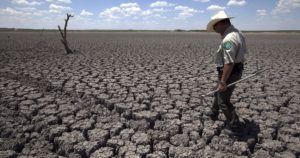I’m going to have to do the virtually unheard of thing later today: At not quite the halfway point in August, I’m going to empty our rain gauge, which is full of water.
We’ve gotten slightly more than 5 inches of rain at our humble abode in southwest Amarillo so far this month. My wife and I empty it at the end of each month before waiting for more rainfall. This month has been a soaker, man!
The National Weather Service station near Rick Husband Amarillo International Airport reports that Amarillo has received 19 inches of rain year to date; that’s 5 inches more than normal and 6 inches more than we had at this time in 2016.
So, put another way, we’ve achieved just about our average annual amount of precipitation — and we still have more than four months to go in this calendar year.
All of this begs the question: Is the drought over?
I’ve heard it said about the crippling drought the High Plains endured in 2011 that it would take an epic amount of rain to bring us officially out of drought status. I cannot remember the specifics, but given that the Ogallala Aquifer takes so very long to recharge given its depth that the rain has to fall in virtually biblical amounts to break the drought.
I’m going to continue believing that and monitor my water use accordingly.
We don’t have one of those automated irrigation systems in our yard. So that’s not a particular issue for my wife and me. We serviced our outdoor faucets during the depths of the drought, so we’re good there. We do things in the kitchen such as turn on the sink faucet sparingly when washing dishes. We remodeled one of our bathrooms a couple of years ago and had one of those “gravity flush” toilets installed, which saves water.
We’re not paragons environmental purity. I don’t intend to portray us as such. Water preservation, though, remains on the top of my mind’s awareness, even when it’s pouring out of the sky.
I keep thinking, too, about that fabulous PBS documentary “The Dust Bowl” that aired not long ago. It told the terrible, horrifying story of how prolonged drought and reckless farming techniques formed a sort of “perfect storm” that created what has been called the nation’s “worst manmade environmental catastrophe.” The Texas and Oklahoma panhandles were in the bullseye of that hideous event.
Our farming techniques have improved since the 1930s. Yes, we can control how we take care of our land. The return of the kind of Dust Bowl-era drought, though, is far beyond our meager effort to dictate to Mother Nature.
Let’s keep that in mind — even as we welcome the rain that keeps drenching us.

